25 April 2025
Global Market Outlook
Global Market Outlook
Filtering out the noise
Unexpectedly high US trade tariffs have created greater uncertainty than usual. Our base case still assumes a soft landing for the US economy, but the risk of a hard landing has risen. We now see equities and bonds as core holdings, but remain Overweight gold.
Within equities, we continue to believe a balanced approach across major regions is sensible amid uncertainty. US equities should still do well in a soft-landing scenario, but we also see opportunities in European and Asian equities.
Within bonds, Developed Market Investment Grade government bonds should benefit from a softening of bond yields in a slow growth environment. The sharp drop in the USD could be the start of a more prolonged decline.
Why are US government bonds attractive?
Where are the bargains among equity sectors?
Are quantitative models still bullish on equities?
Strategy
Investment strategy and key themes
|
|
||||
|

12m Foundation Overweights:
- Gold
- DM IG Government bonds
Opportunistic ideas – Equities
- US software, communications, major banks
- China non-financial high dividend SOEs and Hang Seng Technology Index
- European banks, industrials
Opportunistic ideas – Bonds
- US Treasury Inflation-Protected Securities (TIPS)
- US Agency mortgage-backed securities (MBS)
Filtering out the noise
- Unexpectedly high US trade tariffs have created greater uncertainty than usual. Our base case still assumes a soft landing for the US economy, but the risk of a hard landing has risen. We now see equities and bonds as core holdings, but remain Overweight gold.
- Within equities, we continue to believe a balanced approach across major regions is sensible amid uncertainty. US equities would still do well in a soft-landing scenario, but we also see opportunities in European and Asian equities.
- Within bonds, Developed Market (DM) Investment Grade (IG) government bonds should benefit from a softening of bond yields in a slow growth environment. The sharp drop in the USD could be the start of a more prolonged decline.
Tariffs raise risks to growth outlook
The US ‘Liberation Day’ trade tariff announcements proved to be harsher than markets expected. While partial rollbacks helped temper market reaction, a high level of volatility meant that, at one point, the S&P500 had achieved a peak-to-trough drawdown of approximately 20% this year. Bond yields oscillated due to, first, growth worries, and then rising inflation concerns, while gold trended firmly higher.
Last month, we discussed what appeared to be a relatively balanced outlook for US economic growth. Two factors have arguably deteriorated since then. First is the level of US trade tariffs, which impose a negative drag on US and global growth. Second is the worsening of business and consumer confidence. Together, these make the case that growth is likely to slow in the coming quarters.
Our base case continues to be one of a soft landing i.e., US growth slows, but avoids contraction (50% probability). However, the risk of the US economy tipping over into recession i.e., two quarters of negative growth, have clearly risen (30% probability). In our view, trade negotiations between the US and ex-China partners remain the key factor to watch, as they are likely to determine where the average US tariff level, and hence the magnitude of its drag on growth, settles.
Fig. 1 US trade policy has resulted in very high policy and market uncertainty
US policy uncertainty index

Equities a core holding amid uncertainty
The unusually high level of policy uncertainty (and a narrow gap between soft landing and recession scenarios) means risk/reward is less favourable towards taking strong directional views in equities at this time. Hence, we trim our equities view to a core holding (Neutral). Our preference at this time sits with portfolio hedges – gold and high quality bonds.
This is consistent with our quantitative Equity-Bond Risk Model, which argues that downside risks for equities and bonds remain higher than usual and that we remain in an environment favourable for gold. Our stock-bond model is more constructive, suggesting a small Overweight to equities is appropriate, but we override this based on qualitative input.
Within equities, we continue to prefer a balanced exposure across major regions. In the long term, higher tariffs and resilient, rather than efficient, supply chains pose risks to the historically elevated US profit margins.
A soft-landing scenario should support US equities via the stabilisation of earnings expectations. US tariffs also raise downside risks for other major markets, but in Europe, we expect these to be at least partly mitigated by Germany’s fiscal spending package and the ECB’s rate cuts.
In Asia ex-Japan, we retain our preference for China equities. US tariffs are admittedly a headwind to growth. However, we believe (i) inexpensive valuations, which suggest more of this risk is priced, (ii) DeepSeek-led optimism, and (iii) indications that further policy support may be forthcoming can help offset trade uncertainty. We also retain a core holding view on Indian equities, with the market’s pre-Liberation Day weakness already pricing in significant downside risk.
Gold rally defies expectations
Gold remains attractive amid the current uncertainty. As we have noted before, gold is likely to benefit in the current environment from (i) strong central bank demand amid elevated US policy uncertainty, and (ii) investor demand to mitigate inflationary (or stagflationary) risks in a world of higher trade tariffs. We maintain our Overweight view.
Fig. 2 The USD appears to be breaking below its 2022-2025 range, signalling potential weakness ahead
USD index (DXY)
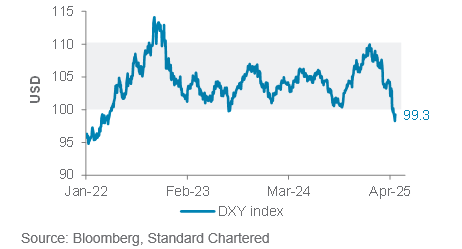
Adding to DM IG government bonds
Unusually high uncertainty means we are now Overweight DM IG government bonds. In our view, it is attractive to add while the US 10-year government bond yield remains above our 12-month expected range of 4.00-4.25%.
The rebound in US bond yields was initially driven by fears of an unwinding in arbitrage trades. However, we believe such worries are unwarranted in the long term, as the Fed has the tools (and experience, in 2020) to address such unexpected spikes in yields. This means we expect the US 10-year government bond yield to move gradually back towards 4% in a soft-landing scenario – and lower in a recessionary scenario.
Broadly, our preference for a diversified approach continues to argue in favour of multi-asset income strategies to generate income. Within this, we maintain a preference for sub-financials over DM High Yield bonds and US Agency MBS bonds over DM IG government bonds.
Start of a USD bear market?
A key recent development has been the break lower in the USD index (DXY) below the 100-110 range that has persisted since 2022. This has occurred independent of relative interest rate spreads, suggesting the tariff policy shock is the catalyst.
We expect this break lower to persist, with risks of further USD weakness after a brief consolidation. Hence, we expect safe haven currencies including the JPY and CHF to strengthen against the USD (to 140 and 0.78 respectively) over 12-months. A weak USD is also supportive for non-US equities.
Diversified equity sectors, inflation protection
We are implementing diversification across our equity sector preferences as well. In the US, we now favour a mix of cyclical (technology software, communication services, financials) and defensive (healthcare, utilities) sectors. In bonds, we add a new opportunistic idea in US Treasury inflation-protected bonds (TIPS) to benefit from (and hedge against) any uptick in long-term inflation expectations.
Foundation asset allocation models
The Foundation and Foundation+ models are allocations that you can use as the starting point for building a diversified investment portfolio. The Foundation model showcases a set of allocations focusing on traditional asset classes that are accessible to most investors, while the Foundation+ model includes allocations to private assets that may be accessible to investors in some jurisdictions, but not others.
Fig. 3 Foundation asset allocation for a balanced risk profile

Fig. 4 Foundation+ asset allocation for a balanced risk profile
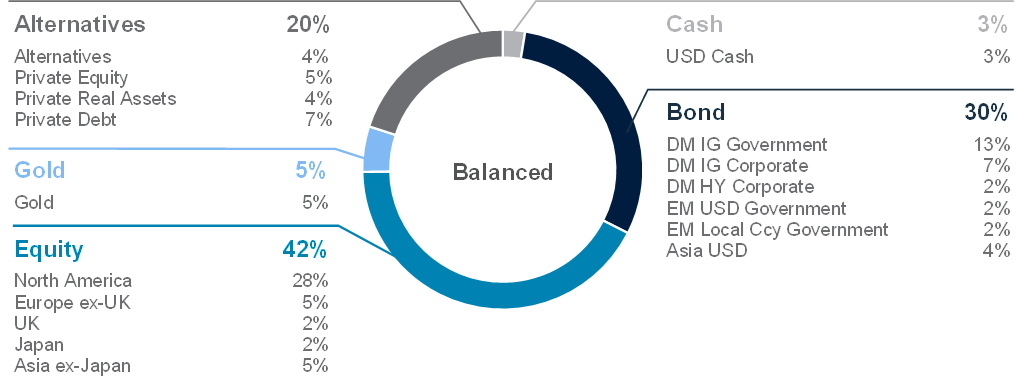
Fig. 5 Multi-asset income allocation for a moderate risk profile

Source: Standard Chartered
Foundation: Our tactical asset allocation views
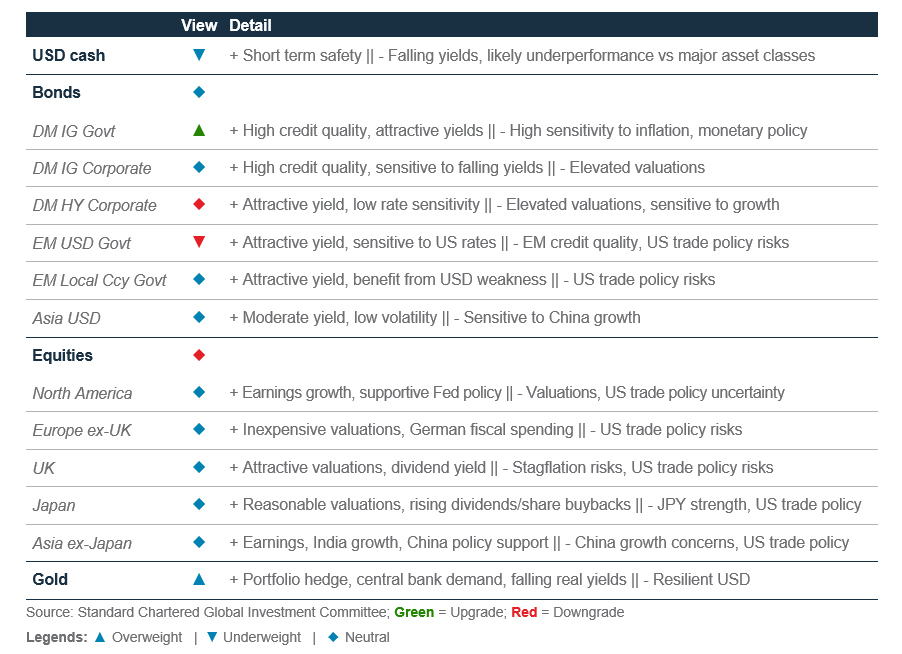
Fig. 6 Performance of our Foundation Allocations*

Source: Bloomberg, Standard Chartered; *12-month performance data from 24 Apr 2024 to 24 Apr 2025, 3-month performance from 24 Jan 2024 to 24 Apr 2025, 1-month performance from 24 Mar 2025 to 24 Apr 2025.
Perspectives on key client questions
|
|
||||
US government bonds: evaluating the outlook amid trade tensions, stagflation risks and Fed policy
Since President Trump’s ‘Liberation Day’ tariff announcement on 2 April, the US government bond market has experienced heightened volatility. The US 10-year bond yield initially fell following the announcement but quickly reversed course, spiking to nearly 4.6%. While yields have since stabilised, they remain above pre-tariff announcement levels. This instability, coupled with losses in US government bonds themselves amid the equity market sell-off, has prompted scrutiny over their role as safe havens (Fig. 8).
In this segment, we assess the outlook for US government bonds through three critical questions. First, is there a ‘Fed Put’ in US government bonds that might limit further yield surges? Second, could China retaliate against US tariffs by accelerating the sale of its US government bond holdings? And finally, how might the Fed respond if stagflation – rising inflation amid slowing growth – were to materialise?
The Fed Put: conditional and situational
A historical review of the Fed reveals that the bank does not routinely intervene in government bond markets simply due to rising yields. While the Fed usually seeks to ensure orderly yield movements via verbal signals, direct intervention is reserved only for cases where yields surge rapidly in a manner disconnected from fundamentals, or when such moves threaten financial stability or market functioning.
This framework has been evident during periods of rapid yield gains since 2000. Examples of direct Fed intervention, which include policy changes and introduction of policy tools, are more common during periods when rising yields threatened to undermine a fragile economic recovery, such as in 2003, 2009 and the 2013 ‘Taper Tantrum’. Meanwhile, threats to the functioning of bond markets, characterised by severe illiquidity, such as during the COVID-19 panic, led the Fed to launch ‘unlimited quantitative easing’ and emergency lending facilities to restore order.
In contrast, the Fed is less likely to intervene when yield increases are orderly and reflect economic fundamentals. Following the COVID-19 pandemic, when yields rose due to stronger growth and elevated inflation, the Fed welcomed the

Fig. 7 Fed intervention in the US government bond market has only occurred when yield gains were disconnected from fundamentals or there were threats to financial stability and orderly market functioning
US 10-year government bond yields and periods of yield gains that saw direct Fed intervention and no intervention

Source: Bloomberg, Standard Chartered; *Direct intervention includes policy changes (eg, extension of asset purchases) or introduction of policy tools (eg, use of emergency lending facilities). No intervention involves verbal management of yield gains only
moves and refrained from acting. Today, while yields have risen, the movement has not been deemed disorderly, and the broader economy remains resilient. Fed officials, including Collins, have offered verbal reassurances, but there is no evidence of market dysfunction, nor signs that yields are diverging materially from economic reality. As such, the threshold for direct intervention remains unmet, and further upside in yields cannot be ruled out amid tariff uncertainty.
Fig. 8 US government bonds have not been effective diversifiers in recent years
S&P 500 drawdowns vs cumulative Treasury returns
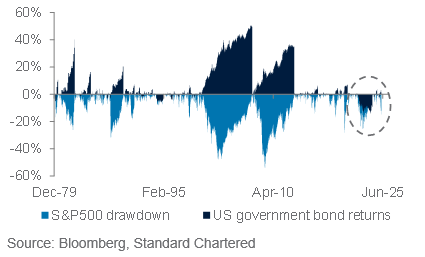
Modest impact from foreign selling
Amid rising US-China tensions, speculation has grown that China might retaliate by selling its sizeable US bond holdings. However, historical precedent suggests the Fed typically does not respond to foreign selling of US bonds that is unrelated to domestic economic conditions or market stress. Since 2018, China and Russia have been reducing their exposure to US government bonds, largely without triggering a significant Fed response. The more pertinent historical parallel lies in the mid-1990s, during US-Japan trade tensions. Back then, yields rose after Japan made implicit threats to sell bonds in response to US pressure on trade, but the Fed did not intervene, leaving the federal government to manage trade negotiations instead.
From China’s perspective, aggressive selling carries considerable costs. A rapid liquidation of US bond holdings would likely trigger substantial losses and risk CNY appreciation if proceeds are repatriated, undermining China’s export competitiveness – especially damaging when tariffs are already weighing on trade. Moreover, such a move may backfire: the Fed could step in as a buyer of last resort, and global investors might view higher yields as a buying opportunity, limiting the effectiveness of China’s strategy. This means China could bear huge costs for little strategic gains.
In addition, a full-scale dumping would also be a one-time lever: once used, China erodes its bargaining power in the future. Practical constraints further complicate execution. The global financial system lacks sufficient safe, liquid alternatives to absorb China’s reserves. The Euro area’s bond market is fragmented, while gold and currency alternatives such as the
JPY or GBP lack the depth and capacity to absorb large scale inflows. While a symbolic partial selling of US government bonds is conceivable, the probability of wholesale dumping remains low, barring the onset of a significant escalation of tensions, which risks China’s US assets being frozen.
Fig. 9 China has already been reducing its US government bond holdings since 2018
Select direct foreign holdings of US government bonds
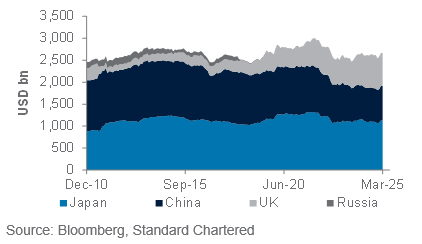
Stagflation: a complicated policy trade-off
The possibility of stagflation complicates the Fed’s dual mandate, but broadly, history suggests the Fed’s reaction function to stagflation depends on a few factors. First, the Fed is likely to respond to the dominant economic challenge. If inflation rises faster than unemployment, for example, the Fed is likely to prioritise inflation and raise rates. Second, if inflation is deemed to be transitory, for instance due to oil prices spikes such as during the Gulf War, then the Fed may tolerate higher inflation in the interest of supporting employment. Third, if there are signs of inflation broadening and turning persistent, with the unanchoring of long-term inflation expectations, then the lessons of Volcker’s era inflation loom large, and the Fed is likely to prioritise inflation.
Applying this framework to the current context means that if employment deteriorates at the same time as inflation is rising, then the Fed is likely to prioritise employment, as tariff-induced inflation is likely to be seen as transitory. On the other hand, if the labour market remains resilient but signs of tariff-induced inflation emerge, the Fed may turn hawkish. However, this raises the risk of a more severe downturn further ahead, as the Fed requiring clear evidence of economic deterioration before resuming rate cuts heightens the risk of it falling behind the curve.
Upside bias to persist for now, but likely not for long
In the near-term, the upside bias in US long-dated bond yields is likely to persist as long as US policy uncertainty remains. However, with medium-term risks skewed towards slower growth, and no clear strategic gains for China to accelerate the selling of its US bond holdings, the upside to yields is likely to be limited. Should a US recession or stagflation materialise, the Fed is likely to prioritise employment and cut interest rates. This should ultimately lead to lower yields down the road.
Macro overview – at a glance
Our macroeconomic outlook and key questions
|
Key themes
US downturn risks rising: A US economic soft landing remains our base case scenario, but the odds of a US recession have risen to 30% from 20% a month ago, in our view, amid rising policy uncertainty. President Trump’s tariffs, even if kept at the 10% base rate, are likely to hurt growth and lift inflation this year. Tax and Fed rate cuts (we expect 75bps of cuts in the next 12 months) and deregulation should help a recovery by 2026. Risk: A delay in Fed rate cuts due to elevated near-term inflation.
ECB to cut further, BoJ to hike: We expect the ECB to cut rates by another 50bps over the next 12 months as trade uncertainty dampens growth. Germany’s incoming coalition agreed to ease fiscal restrictions to boost infrastructure and defence spending, which should help partly offset the impact of US tariffs on Euro area growth. Unlike other Developed Market central banks, the BoJ is likely to hike rates further this year as a tight labour market fuels wages and inflation.
China to ease policy further: China is likely to further ease fiscal, monetary and credit policies to stimulate domestic demand and offset the deflationary impact of US tariffs. China has been the main target of US tariffs, although Trump has said a deal could happen “pretty quickly”. A prolonged trade war is a key risk, while a trade deal is a likely catalyst for a growth resurgence.
Key chart
US growth estimates have been downgraded the most lately amid rising policy uncertainty. While US tariffs are likely to increase near-term inflation, investors do not expect long-term inflation to rise
Fig. 10 US leads downgrades to global growth forecasts amid rising policy uncertainty
Consensus 2025 GDP growth estimates; US 1-year and 10-year inflation estimates*

Macro factors to watch
Trade policy reversal, spillover of US tariffs: Our base case is US President Trump will use the threat of tariffs to negotiate better trade/investment deals for the US, before shifting focus to tax cuts and deregulation to revive the economy. This strategy is likely to hurt near-term growth but set the economy on a more sustainable growth path.
However, we need to watch out for the spillover effects of tariffs. According to the Yale Budget Lab, the average tariff rate is likely to rise to c.18%, from c.3% at end-2024, even accounting for the 90-day pause in tariffs and the likely consumption shift away from Chinese goods. This would be the biggest trade shock to the economy since the 1930s.
The next focus will be on the impact of tariffs and uncertainty on consumption, investment, job creation and inflation expectations. Although the US job market remains resilient, soft data suggests waning consumer and business confidence and rising inflation expectations among consumers. As near-term inflation risks rise, there is a risk the Fed delays rate cuts.
German fiscal boost, trade talks: The German parliament’s decision to ease debt limits to boost infrastructure and defence spending is likely to lift Germany’s potential growth by 2ppt over the next decade. Once the incoming coalition takes charge in May, focus is likely to shift to the pace of the implementation of the stimulus and on trade deals with the US. The impact of both is likely to be felt only from next year, leaving the ECB as the primary support to near-term growth. Slowing economic activity and inflation and tighter financial conditions should encourage the ECB to cut rates by 50bps over the next 12 months, with risk of more cuts if growth slows.
Accelerated China stimulus: The US-led trade war seems to be focused on China. This is likely to increase deflationary pressures on China and Emerging Markets. We expect China to accelerate fiscal spending and ease bank reserve requirements to boost lending and revive domestic demand, countering the impact of US tariffs. China has cut its reliance on US exports since Trump’s first term, but it is now more reliant on global exports, making a broader trade war a key risk. A trade deal with the US and/or Europe is an upside risk.
Asset Classes
Bonds – at a glance
|
|
||||
Key themes
We continue to view global bonds as a core holding. Uncertainty over US trade policy and, by extension, the growth and inflation outlook, have driven yield premia (the spread on higher yielding bonds over risk-free assets) higher. However, our core expectation for an economic soft landing, aided by Trump’s likely pivot to tax cuts and deregulation policies and monetary policy flexibility should help cap bond yields and support future bond returns. Additionally, we believe headline yields remain attractive, particularly compared to cash, helping to mitigate reinvestment risk when central banks cut rates further. Risks to our view include a reduced rate cut expectations and a surge in term premia in long-term bonds due to sticky inflation and rising government debt.
We upgrade Developed Market (DM) Investment Grade (IG) government bonds to Overweight. Major central bank rate cuts should support performance. Additionally, we anticipate interest rate volatility to subside gradually as leveraged positions in the market are partially closed. We downgrade Emerging Market (EM) USD government bonds to Underweight and keep EM local currency (LC) government bonds a core holding (Neutral). Investors are demand high yield premia on bonds from major exporting countries, keeping yields elevated for EM bond asset classes. However, a weakened USD gives EM central banks greater monetary policy flexibility and supports EM LC bonds relative to their USD counterparts.
DM IG corporate bonds remain a core holding (Neutral). While tight yield premia indicate rich valuations, we believe these are supported by solid fundamentals. We move DM High Yield (HY) corporate bonds to Neutral as demand for higher risk premia is balanced by low default expectations under an economic soft-landing scenario. Asia USD bonds are also core holdings (Neutral). Although most Asian economies face US tariff risks, stronger external balances, flexible monetary policy tools and robust domestic support are capping significant spikes in yields.
Key chart
Term premia on long-term bonds still face upside risk, but our expectation of an economic soft-landing scenario suggests lower bond yield prospects and cash-beating returns
Fig. 11 Global bond yields remain intact, despite higher yield premia; DM IG government bonds delivered positive returns since Trump’s ‘Liberation Day’ tariff announcement
Global bond yields and yield premia; Total returns of DM IG vs EM USD government bonds

Maintain opportunistic idea: US Agency mortgage-backed securities
This asset class continues to offer a yield pick-up over comparable government bonds. The asset class has a strong and positive correlation with government bonds, which is likely to support performance as investors look for more stable and predictable returns. Risks include a stagflation scenario.
Maintain opportunistic idea: US Treasury Inflation-Protected bonds
We initiated this opportunistic idea on 11 April 2025 (please refer to Weekly Market View, 11 April 2025, for details) as a hedge against tariff-induced inflationary risks. Risks to this trade include a de-escalation of the tariff war and a change to a more benign inflationary outlook.
Close convertible bonds and Asia HY bonds
We have closed our opportunistic ideas on global convertible bonds and Asia HY bonds with holding period gains of 6.2% and 0.2%, respectively.
Equity – at a glance
|
|
||||
|
|
||||
Key themes
We downgrade global equities to Neutral (core holding) and maintain a Neutral stance across all major regions. Policy uncertainty and a high level of volatility is resulting in a poor risk-reward. This is driving our preference to be Neutral, until the uncertainty subsides. US equities are under pressure as cracks emerge in the US exceptionalism narrative. Earnings are being revised down, but we still expect the market to recover under our economic soft-landing base case scenario as growth stays positive. The current earnings season is the main catalyst in the near term.
Europe ex-UK equities are expected to benefit from fiscal support, although tariff-related headwinds could weigh on earnings growth. UK equities provide more defensive exposure, resulting in more resilience in a market downturn. However, a lack of growth sectors could constrain the potential of outperformance. Japan equities face challenges from a stronger JPY and persistent foreign capital outflows, despite Japan’s priority in engaging in trade negotiations with the US.
Within the Asia ex-Japan region, we remain Overweight China equities. China’s earnings outlook is bolstered by the low-cost DeepSeek chatbot breakthrough. Also, policy stimulus supports a valuation re-rating, which should offset the geopolitical uncertainties and structural concerns. We remain Neutral India equities, which is relatively insulated from tariff concerns, but faces headwind from negative earnings revisions. On the other hand, we remain Underweight ASEAN, asthe redirection of China exports is intensifying competition for domestic ASEAN businesses and further weakening earnings momentum.
Key chart
Diversifying across different markets in the face of volatility
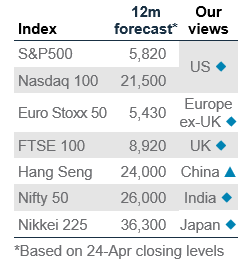
Fig. 12 Asia ex-Japan and China equities’ 12-month forward earnings growth estimates are moving higher, while US growth estimate is moving lower. US policy uncertainty is resulting in relatively elevated volatility

Tariff woes yet to fade
We downgrade global equities to Neutral within our foundation portfolio, as policy uncertainty and recession concerns imply a higher equity risk premium. We are cautious on risky assets near term with the associated volatility but expect more clarity to emerge over the next few months towards a soft-landing scenario, which would support a recovery in global equities.
We remain Neutral US equities following the recent sell-off amid solid corporate fundamentals and earnings growth. Potential tailwinds of deregulation and tax cuts are overshadowed by elevated market volatility on policy uncertainty. Valuations still appear expensive, with the 12m forward P/E ratio at a 17% premium to its historical average.
Within Asia ex-Japan, we trim the scale of Overweight in China equities as the weight of US tariffs appears to focus on China. China’s economic data is still robust with supportive domestic policies, which should continue to support market stability. The focus remains on tensions with the US and concerns on China’s relationship with its other trade partners. Within China, we favour offshore equities versus their onshore counterpart due to a higher composition of technology-related stocks – an area which has performed robustly since the start of year and where we expect further growth.
We are Neutral India equities within Asia ex-Japan. It is relatively insulated from tariff concerns but faces near-term headwind from negative earnings revisions.
Equity opportunistic views
|
Keep calm and carry on
- We have seven opportunistic equity buy ideas where we target positive absolute returns. Since President Trump’s tariff announcements on 2 April, all ideas have traded down along with the broader market. However, we continue to believe these ideas can recover as the narrative for our soft-landing base case emerges in the next few months.
- Within the US, tariffs would likely imply higher costs, so we prefer companies with strong pricing power (technology software) or those less vulnerable to a trade war (communication services). Major banks have reported solid Q1 earnings, with deregulation benefits to come.
- Outside the US, companies involved in the US supply chain face potential disruption. We prefer companies with domestic exposure (Europe banks and China non-financial high dividend SOEs) or those having an offsetting stimulus (Europe industrials and Hang Seng technology).
Opportunistic buy ideas
US technology software: Retaliation against the US has been focused on goods, not services, leaving software companies resilient. Furthermore, we see strong pricing power amongst the deeply embedded software companies. A decline in the cost of AI tools supports software products and development. Weakness in corporate IT spending is a risk.
US communication services: Attractive growth continues with online entertainment and AI applications. Digital advertising may slow along with the economy, but valuations are pricing this in. Advertising softness is a risk.
US major banks: Q1 results were strong, while guidance has been reasonable. We believe deregulation benefits still lie ahead, with potentially greater share buybacks. A sharp slowdown in the US economy is a risk.
Europe banks: Over two-thirds of revenue is derived domestically, resulting in a domestic focus. Positive earnings revisions have been supporting attractive dividend yields and share buybacks, which we expect to continue. A sharp slowdown in Europe’s economy is a risk.
Europe industrials: A fiscal boost in infrastructure and defence spending would support industrials. The Aerospace and defence segment is the largest in the industrial sector (25% index weight) – apart from defence, it benefits from a rise in global air travel. Meanwhile, infrastructure spending would benefit the sector members selling electrical equipment and machinery. A downturn in Europe’s economy is a risk.
China non-financial high dividend SOEs: We continue to like the stability of high-dividend SOEs, which have
predominantly domestic exposure. Non-financial SOEs are less exposed to the troubled property sector. Adverse regulatory changes are a risk.
Hang Seng technology: We prefer a barbell approach in China, with the technology sector complementing income stability from high-dividend SOEs. Policymakers’ support for AI and technology development is improving the earnings outlook. There is also significant valuation re-rating potential as further policy stimulus is unveiled. Weaker-than-expected stimulus is a risk.
Fig. 13 Opportunistic buy ideas
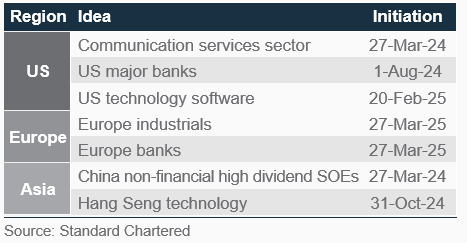
Sector views: technology growth continues
We expand our US barbell strategy, upgrading the defensive utilities sector to Overweight, alongside the defensive healthcare sector and growth-oriented communication and technology sectors. In Europe, we downgrade energy to Underweight amid weak oil prices. In China, we maintain exposure to improving consumption and AI adoption with our preference for technology, communication and discretionary.
Fig. 14 Our sector views by region
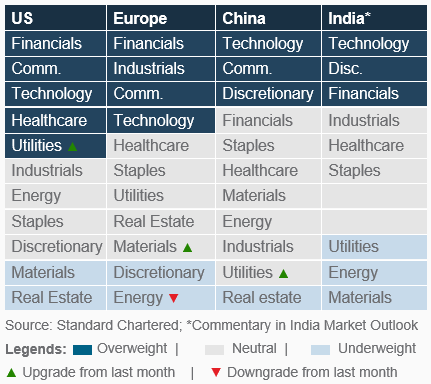
FX – at a glance
|
Key themes
We expect the USD index (DXY) to test resistance at 99.5 in the near term and consolidate at lower levels into 2026 amid US policy uncertainty. The FX market has entered a period of renewed volatility, driven by uncertainty in US trade policies. Meanwhile, expectations of rising near-term inflation should keep the Fed cautious in its approach to interest rate adjustments, supporting the USD in the near term. However, trade policy uncertainty may hinder US economic growth and lead to fund rotations out of the US, potentially leading to a softer dollar over a 12-month horizon. We now see downside risks primarily driven by renewed tariff noise. Reduced US policy uncertainty or a decisively hawkish turn in Fed policy is an upside risk for the USD.
We expect EUR/USD to settle around 1.14 on a 3-month horizon and edge towards 1.15 on a 12-month horizon. The GBP is also expected to show resilience over the next three months. The BoE is likely to remain cautious against rate cuts due to lingering concerns over supply-side constraints, high wage growth and persistent inflation in the services sector, which should keep GBP/USD well supported around 1.33-1.34. The JPY is likely to strengthen gradually, as markets have largely priced in expectations of a BoJ rate hike. We expect the USD/JPY pair to trade around 140-142. Meanwhile, the CHF has the most potential to strengthen further. We expect USD/CHF to test 0.78 in 3 months.
Key chart
The VXY index (benchmark for implied volatility in G10 currencies) has risen to 1 standard deviation above the five-year average, suggesting large price swings
Fig. 15 FX volatility has risen to one standard deviation about the five-year average

What is the near-term outlook for FX?
Recent CHF strength reduces the cost of Swiss imports, which in turn is likely to weigh on consumer prices. While the SNB must keep inflation below 2% and prevent a sustained drop in the price level, this suggests officials have some wiggle room when it comes to brief periods of falling prices. While we see recent momentum favouring CHF upside versus the dollar, the CHF’s move against the EUR has been less dramatic. This suggests the CHF may have more room to strengthen further before the SNB intervenes.
Commodity currencies are likely to diverge in performance. AUD/USD is likely to soften over the next three months to 0.61, though we have a modestly bullish bias over 12 months, expecting it to rise to 0.64 on hopes for progress in US-China trade negotiations. Also, Australia’s fiscal policy is likely to be more expansionary if the centre-right opposition
comes to power after the 3 May election. This implies the Reserve Bank of Australia will be cautious in cutting interest rates. The NZD is expected to follow a similar path to the AUD, with any upside likely to remain range-bound between 0.57 and 0.60.However,the CAD’s weakness is likely to persist, with limited upside in oil prices. We see USD/CAD trade around 1.40 over a 12-month horizon.
In Asia, further monetary policy loosening following MAS’s April easing decision may push USD/SGD back to 1.33-1.34. Meanwhile, the market awaits further stimulus and trade talk news from China. We expect USD/CNH to edge towards 7.38 over the next 1-3 months while the underlying economy and inflation remain soft. China is likely to guide the CNH weaker at a cautious pace to offset the impact of US tariffs, leading the USD/CNH pair to test 7.70 in 12 months. We see USD/INR trading around 86 over a 12-month horizon as prospects of foreign equity inflows and a softer US dollar underpin the INR.
Fig. 31 Summary of Asian currency drivers
Gold, crude oil – at a glance
|
|
||||
Key themes
We remain Overweight gold, raising our 3-month and 6-12-month targets to USD 3,400/oz and USD 3,500/oz, respectively. Gold remains a crucial portfolio diversifier, and there has been a surge in demand for gold-backed exchange-traded funds (ETFs) in recent weeks, particularly from Chinese investors. However, after the sharp rally in prices, positionings look stretched (Page 15); we would recommend waiting for a better entry level. Silver, which has lagged gold in recent weeks, can be considered, but silver is not a perfect substitute for gold, given its industrial demand. A credible resolution of US-led trade disputes is a key risk to gold prices, but we see any correction as an opportunity to add to exposure, as central bank demand remains a strong long-term anchor. The PBoC added to its gold reserves for a fifth straight month in March – a trend we see continuing, given China’s gold reserves at 6.5% of total holdings still lag the 15% average among BRICS peers. Rough estimations show that every 1ppt increase in China’s gold holdings as proportion of total reserves would amount to around 400 tonnes of new demand.
We trim our WTI crude oil price expectations to 60/bbl over 3m and 12m horizons. The broader context of significant supply and subdued demand remains unchanged, as does our expectation oil markets remain in a surplus through 2025. US trade policy raises downside risks to economic growth, which in turn raises downside risks to oil demand. On the supply side, OPEC+’s decision to continue unwinding some of its prior supply cuts is likely to exacerbate excess supply. Geopolitics remains a key risk, with any flare-up in the Middle East posing an upside risk to oil prices. However, significant OPEC+ spare capacity means any price rebound is likely to be short-lived. Our view of subdued energy prices, though, are likely to help contain long term inflation expectations, particularly in the US.
Key chart
Fig. 16 Gold’s outperformance over the S&P500 is significant but not unprecedented and far from extreme
Gold’s excess returns vs the S&P 500
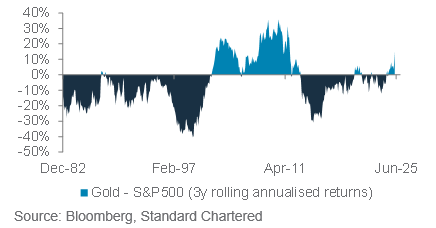
Fig. 18 The gold/silver ratio has crossed 100 for only the second time since 1973
Gold/silver ratio
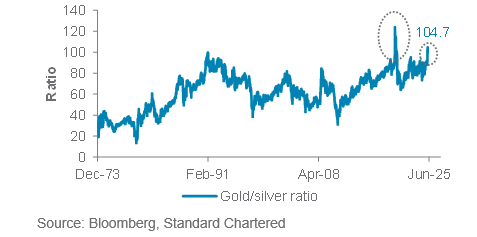
Fig. 17 Inflows into China’s gold ETFs have surged amid US-China trade tensions
China gold ETF inflows and collective holdings

Fig. 19 The oil market is likely to remain in surplus this year, keeping prices in check
Oil supply-demand balance; price estimates
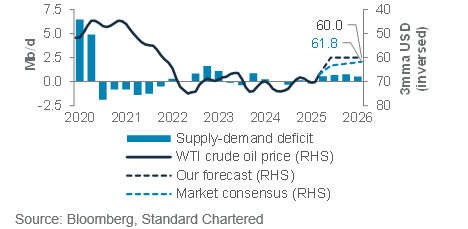
Additional perspectives
Quant perspective
Models are neutral to modestly bullish
|
|
||||
Summary
Our stock-bond model is slightly Overweight equities over bonds in April. The model score rose from -1 to +1 in April (a positive score indicates an Overweight to equities), after it initially fell from a maximum of +5 to 0 in March. The increase in the model score is driven by valuation factors, which view Asia and Developed Market (DM) equities to be cheap. Technical factors are also supportive of equities, as the net declines in stocks look too bearish, and this increases the chance for a bullish reversal. Fundamental factors remain very weak, as all of them are showing negative signals for equities. These factors include a contraction in new orders in the PMI, an elevated macro risk index, a negative economic surprise index and a continuing slowdown in the upward versus downward earnings revisions ratio.
Our technical framework is Neutral equities in the short term. The price actions for non-US markets are currently bullish, as they rebounded strongly after their significant sell-offs in early April. However, our market regime indicators for all equity markets turned bearish as market volatility rose outside of the normal historical range, even when the extremes are considered. To put this into perspective, the magnitude of the sell-off in the S&P500 on 3-4 April amounted to 10%+, and it is only exceeded by Black Friday in 1987, the Global Financial Crisis in 2008 and the COVID-19 pandemic in 2021. Our models will likely retain a Neutral view across all equity markets to manage downside risks until market volatility calms down further.
Our market diversity indicators flag stretched positioning in Gold. The precious metal has rallied more than 28% this year amid tariff uncertainty, and our indicator suggests waiting for a better entry point. Gold was initially flagged for a stretched positioning in late March. It then pared back gains by as much as 4.8% in early April before starting to rise again.
Key chart
Our stock-bond model score rose to 1 from 0 in April, indicating a slight Overweight to equities. The change was driven by valuation and technical factors
Fig. 20 Breakdown of our stock-bond rotation model’s scores since inception in Feb-23
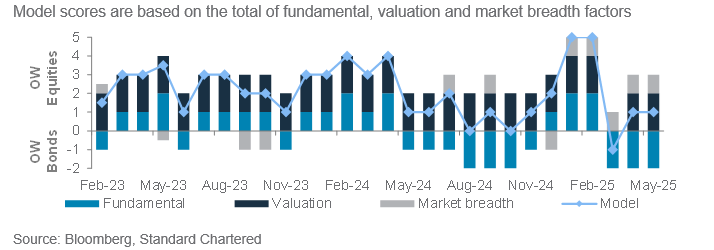
Our market regime indicator projects a recovery in the S&P500 to start in mid-May but near-term price action is still bearish. Given market volatility remains extreme, we retain a Neutral short-term view to reduce risks
Fig. 21 Our technical model is neutral on S&P 500
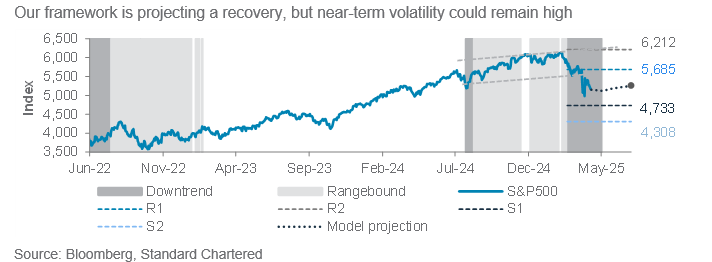
Fig. 22 Long- and short-term quantitative models are neutral risky assets
Long-term models below have a typical time horizon of 3-6 months, while short-term models have a 1-3-month horizon
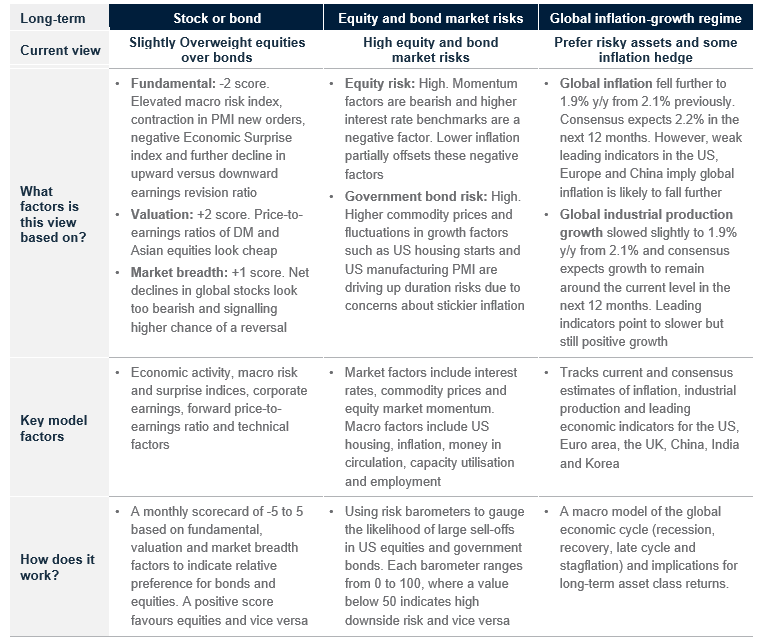
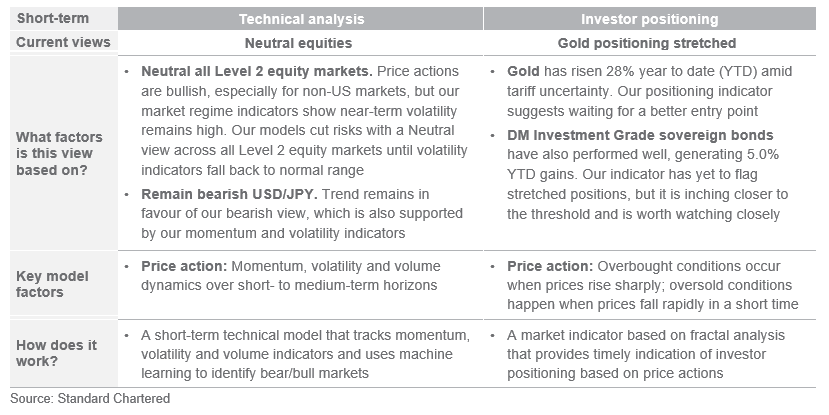
Performance review
Foundation: Asset allocation summary
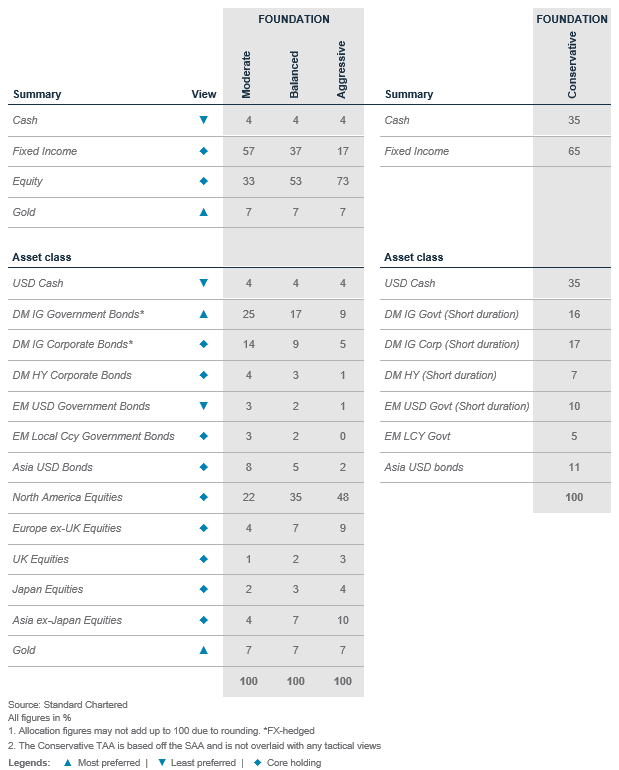
Foundation+: Asset allocation summary
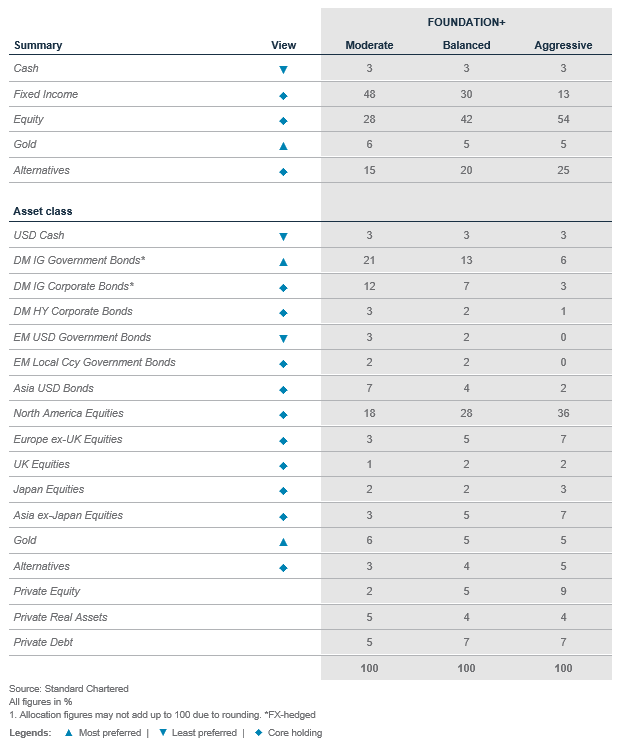
Market performance summary
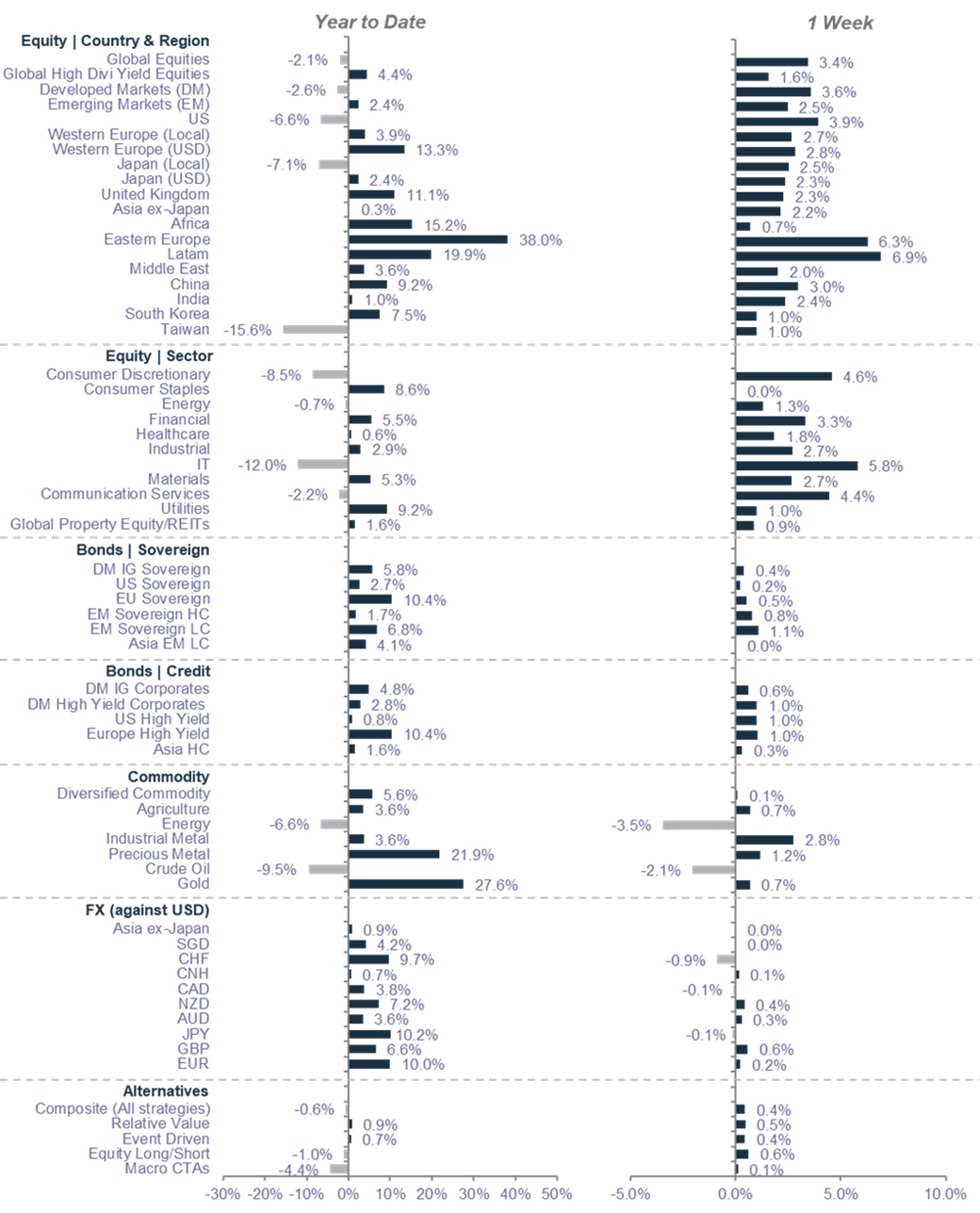
Source: MSCI, JPMorgan, Citigroup, Dow Jones, HFRX, FTSE, Bloomberg, Standard Chartered
*All performance shown in USD terms, unless otherwise stated
*YTD performance data from 31 December 2023 to 24 April 2025; 1-week performance from 17 to 24 April 2025
Our key forecasts and calendar events

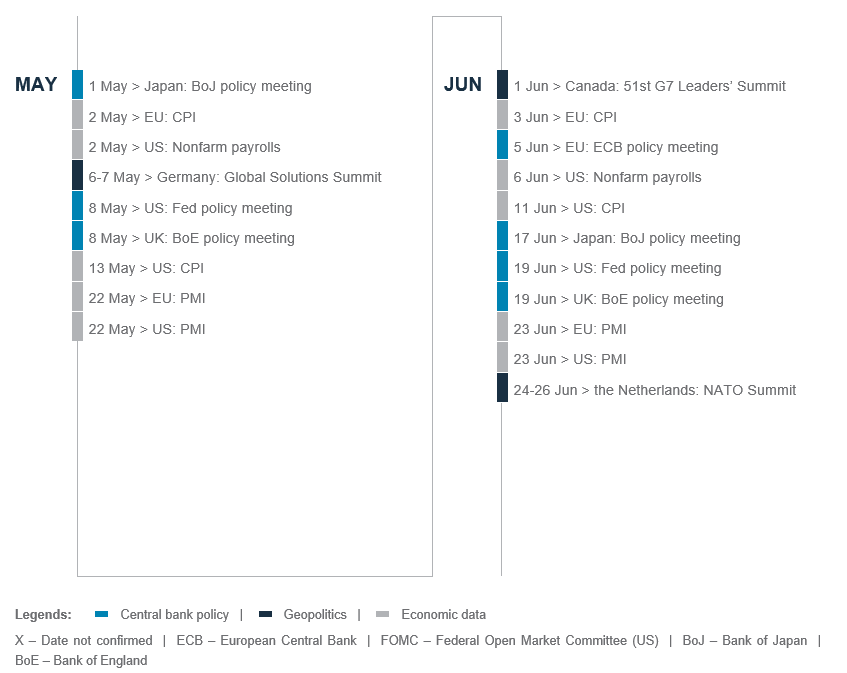
Today, Tomorrow and Forever

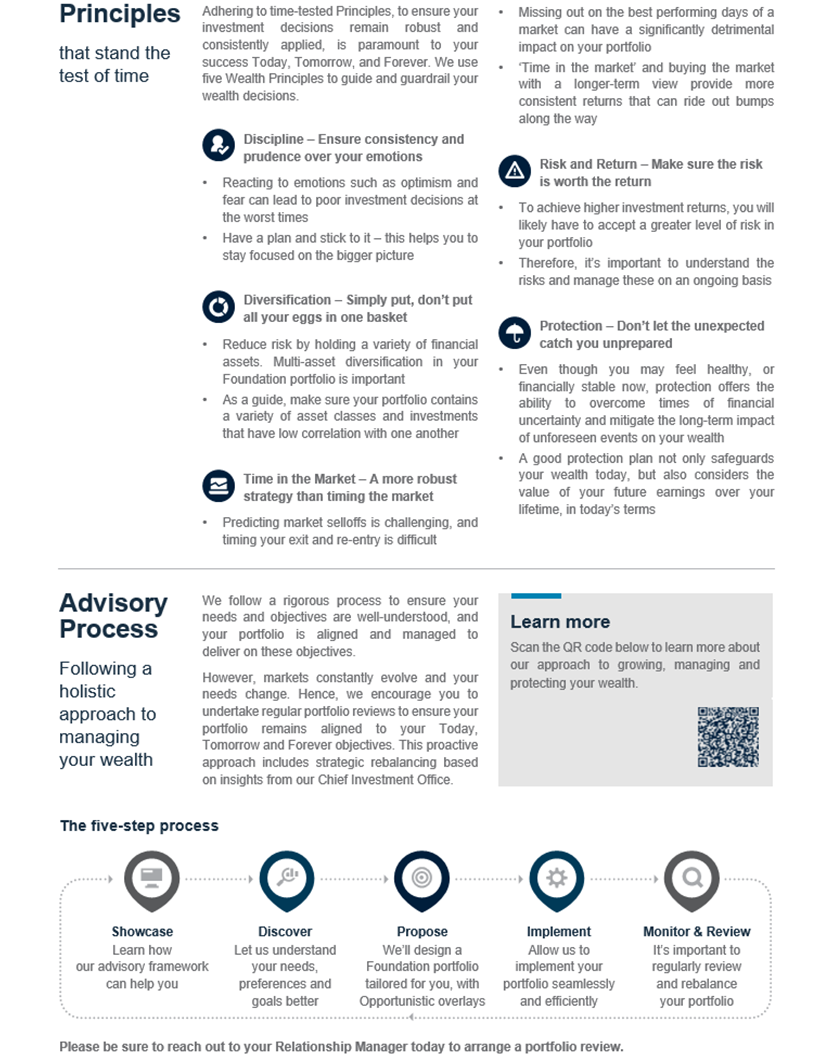

Explanatory notes
1. The figures on page 5 show allocations for a moderately aggressive risk profile only – different risk profiles may produce significantly different asset allocation results. Page 5 is only an example, provided for general information only and they do not constitute investment advice, an offer, recommendation or solicitation. They do not take into account the specific investment objectives, needs or risk tolerances of a particular person or class of persons and they have not been prepared for any particular person or class of persons.
2. Contingent Convertibles are complex financial instruments and are not a suitable or appropriate investment for all investors. This document is not an offer to sell or an invitation to buy any securities or any beneficial interests therein. Contingent convertible securities are not intended to be sold and should not be sold to retail clients in the European Economic Area (EEA) (each as defined in the Policy Statement on the Restrictions on the Retail Distribution of Regulatory Capital Instruments (Feedback to CP14/23 and Final Rules) (“Policy Statement”), read together with the Product Intervention (Contingent Convertible Instruments and Mutual Society Shares) Instrument 2015 (“Instrument”, and together with the Policy Statement, the “Permanent Marketing Restrictions”), which were published by the United Kingdom’s Financial Conduct Authority in June 2015), other than in circumstances that do not give rise to a contravention of the Permanent Marketing Restrictions.
Disclosure
This document is confidential and may also be privileged. If you are not the intended recipient, please destroy all copies and notify the sender immediately. This document is being distributed for general information only and is subject to the relevant disclaimers available at our Standard Chartered website under Regulatory disclosures. It is not and does not constitute research material, independent research, an offer, recommendation or solicitation to enter into any transaction or adopt any hedging, trading or investment strategy, in relation to any securities or other financial instruments. This document is for general evaluation only. It does not take into account the specific investment objectives, financial situation or particular needs of any particular person or class of persons and it has not been prepared for any particular person or class of persons. You should not rely on any contents of this document in making any investment decisions. Before making any investment, you should carefully read the relevant offering documents and seek independent legal, tax and regulatory advice. In particular, we recommend you to seek advice regarding the suitability of the investment product, taking into account your specific investment objectives, financial situation or particular needs, before you make a commitment to purchase the investment product. Opinions, projections and estimates are solely those of SC at the date of this document and subject to change without notice. Past performance is not indicative of future results and no representation or warranty is made regarding future performance. The value of investments, and the income from them, can go down as well as up, and you may not recover the amount of your original investment. You are not certain to make a profit and may lose money. Any forecast contained herein as to likely future movements in rates or prices or likely future events or occurrences constitutes an opinion only and is not indicative of actual future movements in rates or prices or actual future events or occurrences (as the case may be). This document must not be forwarded or otherwise made available to any other person without the express written consent of the Standard Chartered Group (as defined below). Standard Chartered Bank is incorporated in England with limited liability by Royal Charter 1853 Reference Number ZC18. The Principal Office of the Company is situated in England at 1 Basinghall Avenue, London, EC2V 5DD. Standard Chartered Bank is authorised by the Prudential Regulation Authority and regulated by the Financial Conduct Authority and Prudential Regulation Authority. Standard Chartered PLC, the ultimate parent company of Standard Chartered Bank, together with its subsidiaries and affiliates (including each branch or representative office), form the Standard Chartered Group. Standard Chartered Private Bank is the private banking division of Standard Chartered. Private banking activities may be carried out internationally by different legal entities and affiliates within the Standard Chartered Group (each an “SC Group Entity”) according to local regulatory requirements. Not all products and services are provided by all branches, subsidiaries and affiliates within the Standard Chartered Group. Some of the SC Group Entities only act as representatives of Standard Chartered Private Bank and may not be able to offer products and services or offer advice to clients.
Copyright © 2025, Accounting Research & Analytics, LLC d/b/a CFRA (and its affiliates, as applicable). Reproduction of content provided by CFRA in any form is prohibited except with the prior written permission of CFRA. CFRA content is not investment advice and a reference to or observation concerning a security or investment provided in the CFRA SERVICES is not a recommendation to buy, sell or hold such investment or security or make any other investment decisions. The CFRA content contains opinions of CFRA based upon publicly-available information that CFRA believes to be reliable and the opinions are subject to change without notice. This analysis has not been submitted to, nor received approval from, the United States Securities and Exchange Commission or any other regulatory body. While CFRA exercised due care in compiling this analysis, CFRA, ITS THIRD-PARTY SUPPLIERS, AND ALL RELATED ENTITIES SPECIFICALLY DISCLAIM ALL WARRANTIES, EXPRESS OR IMPLIED, INCLUDING, BUT NOT LIMITED TO, ANY WARRANTIES OF MERCHANTABILITY OR FITNESS FOR A PARTICULAR PURPOSE OR USE, to the full extent permitted by law, regarding the accuracy, completeness, or usefulness of this information and assumes no liability with respect to the consequences of relying on this information for investment or other purposes. No content provided by CFRA (including ratings, credit-related analyses and data, valuations, model, software or other application or output therefrom) or any part thereof may be modified, reverse engineered, reproduced or distributed in any form by any means, or stored in a database or retrieval system, without the prior written permission of CFRA, and such content shall not be used for any unlawful or unauthorized purposes. CFRA and any third-party providers, as well as their directors, officers, shareholders, employees or agents do not guarantee the accuracy, completeness, timeliness or availability of such content. In no event shall CFRA, its affiliates, or their third-party suppliers be liable for any direct, indirect, special, or consequential damages, costs, expenses, legal fees, or losses (including lost income or lost profit and opportunity costs) in connection with a subscriber’s, subscriber’s customer’s, or other’s use of CFRA’s content.
Market Abuse Regulation (MAR) Disclaimer
Banking activities may be carried out internationally by different branches, subsidiaries and affiliates within the Standard Chartered Group according to local regulatory requirements. Opinions may contain outright “buy”, “sell”, “hold” or other opinions. The time horizon of this opinion is dependent on prevailing market conditions and there is no planned frequency for updates to the opinion. This opinion is not independent of Standard Chartered Group’s trading strategies or positions. Standard Chartered Group and/or its affiliates or its respective officers, directors, employee benefit programmes or employees, including persons involved in the preparation or issuance of this document may at any time, to the extent permitted by applicable law and/or regulation, be long or short any securities or financial instruments referred to in this document or have material interest in any such securities or related investments. Therefore, it is possible, and you should assume, that Standard Chartered Group has a material interest in one or more of the financial instruments mentioned herein. Please refer to our Standard Chartered website under Regulatory disclosures for more detailed disclosures, including past opinions/ recommendations in the last 12 months and conflict of interests, as well as disclaimers. A covering strategist may have a financial interest in the debt or equity securities of this company/issuer. All covering strategist are licensed to provide investment recommendations under Monetary Authority of Singapore or Hong Kong Monetary Authority. This document must not be forwarded or otherwise made available to any other person without the express written consent of Standard Chartered Group.
Sustainable Investments
Any ESG data used or referred to has been provided by Morningstar, Sustainalytics, MSCI or Bloomberg. Refer to 1) Morningstar website under Sustainable Investing, 2) Sustainalytics website under ESG Risk Ratings, 3) MCSI website under ESG Business Involvement Screening Research and 4) Bloomberg green, social & sustainability bonds guide for more information. The ESG data is as at the date of publication based on data provided, is for informational purpose only and is not warranted to be complete, timely, accurate or suitable for a particular purpose, and it may be subject to change. Sustainable Investments (SI): This refers to funds that have been classified as ‘Sustainable Investments’ by Morningstar. SI funds have explicitly stated in their prospectus and regulatory filings that they either incorporate ESG factors into the investment process or have a thematic focus on the environment, gender diversity, low carbon, renewable energy, water or community development. For equity, it refers to shares/stocks issued by companies with Sustainalytics ESG Risk Rating of Low/Negligible. For bonds, it refers to debt instruments issued by issuers with Sustainalytics ESG Risk Rating of Low/Negligible, and/or those being certified green, social, sustainable bonds by Bloomberg. For structured products, it refers to products that are issued by any issuer who has a Sustainable Finance framework that aligns with Standard Chartered’s Green and Sustainable Product Framework, with underlying assets that are part of the Sustainable Investment universe or separately approved by Standard Chartered’s Sustainable Finance Governance Committee. Sustainalytics ESG risk ratings shown are factual and are not an indicator that the product is classified or marketed as “green”, “sustainable” or similar under any particular classification system or framework.
Country/Market Specific Disclosures
Botswana: This document is being distributed in Botswana by, and is attributable to, Standard Chartered Bank Botswana Limited which is a financial institution licensed under the Section 6 of the Banking Act CAP 46.04 and is listed in the Botswana Stock Exchange. Brunei Darussalam: This document is being distributed in Brunei Darussalam by, and is attributable to, Standard Chartered Bank (Brunei Branch) | Registration Number RFC/61 and Standard Chartered Securities (B) Sdn Bhd | Registration Number RC20001003. Standard Chartered Bank is incorporated in England with limited liability by Royal Charter 1853 Reference Number ZC18. Standard Chartered Securities (B) Sdn Bhd is a limited liability company registered with the Registry of Companies with Registration Number RC20001003 and licensed by Brunei Darussalam Central Bank as a Capital Markets Service License Holder with License Number BDCB/R/CMU/S3-CL and it is authorised to conduct Islamic investment business through an Islamic window. China Mainland: This document is being distributed in China by, and is attributable to, Standard Chartered Bank (China) Limited which is mainly regulated by National Financial Regulatory Administration (NFRA), State Administration of Foreign Exchange (SAFE), and People’s Bank of China (PBOC). Hong Kong: In Hong Kong, this document, except for any portion advising on or facilitating any decision on futures contracts trading, is distributed by Standard Chartered Bank (Hong Kong) Limited (“SCBHK”), a subsidiary of Standard Chartered PLC. SCBHK has its registered address at 32/F, Standard Chartered Bank Building, 4-4A Des Voeux Road Central, Hong Kong and is regulated by the Hong Kong Monetary Authority and registered with the Securities and Futures Commission (“SFC”) to carry on Type 1 (dealing in securities), Type 4 (advising on securities), Type 6 (advising on corporate finance) and Type 9 (asset management) regulated activity under the Securities and Futures Ordinance (Cap. 571) (“SFO”) (CE No. AJI614). The contents of this document have not been reviewed by any regulatory authority in Hong Kong and you are advised to exercise caution in relation to any offer set out herein. If you are in doubt about any of the contents of this document, you should obtain independent professional advice. Any product named herein may not be offered or sold in Hong Kong by means of any document at any time other than to “professional investors” as defined in the SFO and any rules made under that ordinance. In addition, this document may not be issued or possessed for the purposes of issue, whether in Hong Kong or elsewhere, and any interests may not be disposed of, to any person unless such person is outside Hong Kong or is a “professional investor” as defined in the SFO and any rules made under that ordinance, or as otherwise may be permitted by that ordinance. In Hong Kong, Standard Chartered Private Bank is the private banking division of SCBHK, a subsidiary of Standard Chartered PLC. Ghana: Standard Chartered Bank Ghana Limited accepts no liability and will not be liable for any loss or damage arising directly or indirectly (including special, incidental or consequential loss or damage) from your use of these documents. Past performance is not indicative of future results and no representation or warranty is made regarding future performance. You should seek advice from a financial adviser on the suitability of an investment for you, taking into account these factors before making a commitment to invest in an investment. To unsubscribe from receiving further updates, please send an email to feedback.ghana@sc.com. Please do not reply to this email. Call our Priority Banking on 0302610750 for any questions or service queries. You are advised not to send any confidential and/or important information to Standard Chartered via e-mail, as Standard Chartered makes no representations or warranties as to the security or accuracy of any information transmitted via e-mail. Standard Chartered shall not be responsible for any loss or damage suffered by you arising from your decision to use e-mail to communicate with the Bank. India: This document is being distributed in India by Standard Chartered in its capacity as a distributor of mutual funds and referrer of any other third party financial products. Standard Chartered does not offer any ‘Investment Advice’ as defined in the Securities and Exchange Board of India (Investment Advisers) Regulations, 2013 or otherwise. Services/products related securities business offered by Standard Charted are not intended for any person, who is a resident of any jurisdiction, the laws of which imposes prohibition on soliciting the securities business in that jurisdiction without going through the registration requirements and/or prohibit the use of any information contained in this document. Indonesia: This document is being distributed in Indonesia by Standard Chartered Bank, Indonesia branch, which is a financial institution licensed and supervised by Otoritas Jasa Keuangan (Financial Service Authority) and Bank Indonesia. Jersey: In Jersey, Standard Chartered Private Bank is the Registered Business Name of the Jersey Branch of Standard Chartered Bank. The Jersey Branch of Standard Chartered Bank is regulated by the Jersey Financial Services Commission. Copies of the latest audited accounts of Standard Chartered Bank are available from its principal place of business in Jersey: PO Box 80, 15 Castle Street, St Helier, Jersey JE4 8PT. Standard Chartered Bank is incorporated in England with limited liability by Royal Charter in 1853 Reference Number ZC 18. The Principal Office of the Company is situated in England at 1 Basinghall Avenue, London, EC2V 5DD. Standard Chartered Bank is authorised by the Prudential Regulation Authority and regulated by the Financial Conduct Authority and Prudential Regulation Authority. The Jersey Branch of Standard Chartered Bank is also an authorised financial services provider under license number 44946 issued by the Financial Sector Conduct Authority of the Republic of South Africa. Jersey is not part of the United Kingdom and all business transacted with Standard Chartered Bank, Jersey Branch and other SC Group Entity outside of the United Kingdom, are not subject to some or any of the investor protection and compensation schemes available under United Kingdom law. Kenya: This document is being distributed in Kenya by and is attributable to Standard Chartered Bank Kenya Limited. Investment Products and Services are distributed by Standard Chartered Investment Services Limited, a wholly owned subsidiary of Standard Chartered Bank Kenya Limited that is licensed by the Capital Markets Authority in Kenya, as a Fund Manager. Standard Chartered Bank Kenya Limited is regulated by the Central Bank of Kenya. Malaysia: This document is being distributed in Malaysia by Standard Chartered Bank Malaysia Berhad (“SCBMB”). Recipients in Malaysia should contact SCBMB in relation to any matters arising from, or in connection with, this document. This document has not been reviewed by the Securities Commission Malaysia. The product lodgement, registration, submission or approval by the Securities Commission of Malaysia does not amount to nor indicate recommendation or endorsement of the product, service or promotional activity. Investment products are not deposits and are not obligations of, not guaranteed by, and not protected by SCBMB or any of the affiliates or subsidiaries, or by Perbadanan Insurans Deposit Malaysia, any government or insurance agency. Investment products are subject to investment risks, including the possible loss of the principal amount invested. SCBMB expressly disclaim any liability and responsibility for any loss arising directly or indirectly (including special, incidental or consequential loss or damage) arising from the financial losses of the Investment Products due to market condition. Nigeria: This document is being distributed in Nigeria by Standard Chartered Bank Nigeria Limited (SCB Nigeria), a bank duly licensed and regulated by the Central Bank of Nigeria. SCB Nigeria accepts no liability for any loss or damage arising directly or indirectly (including special, incidental or consequential loss or damage) from your use of these documents. You should seek advice from a financial adviser on the suitability of an investment for you, taking into account these factors before making a commitment to invest in an investment. To unsubscribe from receiving further updates, please send an email to clientcare.ng@sc.com requesting to be removed from our mailing list. Please do not reply to this email. Call our Priority Banking on 02 012772514 for any questions or service queries. SCB Nigeria shall not be responsible for any loss or damage arising from your decision to send confidential and/or important information to Standard Chartered via e-mail. SCB Nigeria makes no representations or warranties as to the security or accuracy of any information transmitted via e-mail. Pakistan: This document is being distributed in Pakistan by, and attributable to Standard Chartered Bank (Pakistan) Limited having its registered office at PO Box 5556, I.I Chundrigar Road Karachi, which is a banking company registered with State Bank of Pakistan under Banking Companies Ordinance 1962 and is also having licensed issued by Securities & Exchange Commission of Pakistan for Security Advisors. Standard Chartered Bank (Pakistan) Limited acts as a distributor of mutual funds and referrer of other third-party financial products. Singapore: This document is being distributed in Singapore by, and is attributable to, Standard Chartered Bank (Singapore) Limited (Registration No. 201224747C/ GST Group Registration No. MR-8500053-0, “SCBSL”). Recipients in Singapore should contact SCBSL in relation to any matters arising from, or in connection with, this document. SCBSL is an indirect wholly owned subsidiary of Standard Chartered Bank and is licensed to conduct banking business in Singapore under the Singapore Banking Act, 1970. Standard Chartered Private Bank is the private banking division of SCBSL. IN RELATION TO ANY SECURITY OR SECURITIES-BASED DERIVATIVES CONTRACT REFERRED TO IN THIS DOCUMENT, THIS DOCUMENT, TOGETHER WITH THE ISSUER DOCUMENTATION, SHALL BE DEEMED AN INFORMATION MEMORANDUM (AS DEFINED IN SECTION 275 OF THE SECURITIES AND FUTURES ACT, 2001 (“SFA”)). THIS DOCUMENT IS INTENDED FOR DISTRIBUTION TO ACCREDITED INVESTORS, AS DEFINED IN SECTION 4A(1)(a) OF THE SFA, OR ON THE BASIS THAT THE SECURITY OR SECURITIES-BASED DERIVATIVES CONTRACT MAY ONLY BE ACQUIRED AT A CONSIDERATION OF NOT LESS THAN S$200,000 (OR ITS EQUIVALENT IN A FOREIGN CURRENCY) FOR EACH TRANSACTION. Further, in relation to any security or securities-based derivatives contract, neither this document nor the Issuer Documentation has been registered as a prospectus with the Monetary Authority of Singapore under the SFA. Accordingly, this document and any other document or material in connection with the offer or sale, or invitation for subscription or purchase, of the product may not be circulated or distributed, nor may the product be offered or sold, or be made the subject of an invitation for subscription or purchase, whether directly or indirectly, to persons other than a relevant person pursuant to section 275(1) of the SFA, or any person pursuant to section 275(1A) of the SFA, and in accordance with the conditions specified in section 275 of the SFA, or pursuant to, and in accordance with the conditions of, any other applicable provision of the SFA. In relation to any collective investment schemes referred to in this document, this document is for general information purposes only and is not an offering document or prospectus (as defined in the SFA). This document is not, nor is it intended to be (i) an offer or solicitation of an offer to buy or sell any capital markets product; or (ii) an advertisement of an offer or intended offer of any capital markets product. Deposit Insurance Scheme: Singapore dollar deposits of non-bank depositors are insured by the Singapore Deposit Insurance Corporation, for up to S$100,000 in aggregate per depositor per Scheme member by law. Foreign currency deposits, dual currency investments, structured deposits and other investment products are not insured. This advertisement has not been reviewed by the Monetary Authority of Singapore. Taiwan: SC Group Entity or Standard Chartered Bank (Taiwan) Limited (“SCB (Taiwan)”) may be involved in the financial instruments contained herein or other related financial instruments. The author of this document may have discussed the information contained herein with other employees or agents of SC or SCB (Taiwan). The author and the above-mentioned employees of SC or SCB (Taiwan) may have taken related actions in respect of the information involved (including communication with customers of SC or SCB (Taiwan) as to the information contained herein). The opinions contained in this document may change, or differ from the opinions of employees of SC or SCB (Taiwan). SC and SCB (Taiwan) will not provide any notice of any changes to or differences between the above-mentioned opinions. This document may cover companies with which SC or SCB (Taiwan) seeks to do business at times and issuers of financial instruments. Therefore, investors should understand that the information contained herein may serve as specific purposes as a result of conflict of interests of SC or SCB (Taiwan). SC, SCB (Taiwan), the employees (including those who have discussions with the author) or customers of SC or SCB (Taiwan) may have an interest in the products, related financial instruments or related derivative financial products contained herein; invest in those products at various prices and on different market conditions; have different or conflicting interests in those products. The potential impacts include market makers’ related activities, such as dealing, investment, acting as agents, or performing financial or consulting services in relation to any of the products referred to in this document. UAE: DIFC – Standard Chartered Bank is incorporated in England with limited liability by Royal Charter 1853 Reference Number ZC18.The Principal Office of the Company is situated in England at 1 Basinghall Avenue, London, EC2V 5DD. Standard Chartered Bank is authorised by the Prudential Regulation Authority and regulated by the Financial Conduct Authority and Prudential Regulation Authority. Standard Chartered Bank, Dubai International Financial Centre having its offices at Dubai International Financial Centre, Building 1, Gate Precinct, P.O. Box 999, Dubai, UAE is a branch of Standard Chartered Bank and is regulated by the Dubai Financial Services Authority (“DFSA”). This document is intended for use only by Professional Clients and is not directed at Retail Clients as defined by the DFSA Rulebook. In the DIFC we are authorised to provide financial services only to clients who qualify as Professional Clients and Market Counterparties and not to Retail Clients. As a Professional Client you will not be given the higher retail client protection and compensation rights and if you use your right to be classified as a Retail Client we will be unable to provide financial services and products to you as we do not hold the required license to undertake such activities. For Islamic transactions, we are acting under the supervision of our Shariah Supervisory Committee. Relevant information on our Shariah Supervisory Committee is currently available on the Standard Chartered Bank website in the Islamic banking section. For residents of the UAE – Standard Chartered Bank UAE does not provide financial analysis or consultation services in or into the UAE within the meaning of UAE Securities and Commodities Authority Decision No. 48/r of 2008 concerning financial consultation and financial analysis. Uganda: Our Investment products and services are distributed by Standard Chartered Bank Uganda Limited, which is licensed by the Capital Markets Authority as an investment adviser. United Kingdom: In the UK, Standard Chartered Bank is authorised by the Prudential Regulation Authority and regulated by the Financial Conduct Authority and Prudential Regulation Authority. This communication has been approved by Standard Chartered Bank for the purposes of Section 21 (2) (b) of the United Kingdom’s Financial Services and Markets Act 2000 (“FSMA”) as amended in 2010 and 2012 only. Standard Chartered Bank (trading as Standard Chartered Private Bank) is also an authorised financial services provider (license number 45747) in terms of the South African Financial Advisory and Intermediary Services Act, 2002. The Materials have not been prepared in accordance with UK legal requirements designed to promote the independence of investment research, and that it is not subject to any prohibition on dealing ahead of the dissemination of investment research. Vietnam: This document is being distributed in Vietnam by, and is attributable to, Standard Chartered Bank (Vietnam) Limited which is mainly regulated by State Bank of Vietnam (SBV). Recipients in Vietnam should contact Standard Chartered Bank (Vietnam) Limited for any queries regarding any content of this document. Zambia: This document is distributed by Standard Chartered Bank Zambia Plc, a company incorporated in Zambia and registered as a commercial bank and licensed by the Bank of Zambia under the Banking and Financial Services Act Chapter 387 of the Laws of Zambia.
